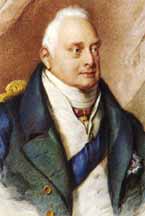Sophia Elizabeth was the daughter of the last Viscount Wenman's sister Sophia and her husband, W.H. Wykeham, of Swalcliffe.
In 1818, Sophia Elizabeth came close to marrying into royalty.
The future King William IV was the third son of King George III, and was not expected to become king. His brother, the Prince Regent, was to become King George IV, whilst William took the title of Duke of Clarence.

King William IV, formerly the Duke of Clarence
The Prince Regent had only one heir, a daughter Charlotte, on whom rested the Hanoverian succession.
When Charlotte unexpectedly died in 1818, the need to preserve the Hanoverian succession dictated that the king's brothers, including William, should marry, lest they be called upon to provide an heir.
William had been living with an actress called Dorothy Jordon, who had given him ten illegitimate children. At the death of Charlotte, however, a suitable partner had to be found, and William began to court the favours of the eligible ladies in and around the royal court.
There were several women courted by the Duke, including Sophia Elizabeth Wykeham, who seemed to many at the time to be on the verge of marrying him. Whatever his feelings for Sophia, however, there was more than personal affection at stake. It is believed that the Prince Regent would not consent to a marriage with Sophia.
In the event, William married Adelaide of Saxe-Coburg and Meinengein in 1818, who bore him two daughters.
At the Prince Regent's coronation as King George IV in 1821, Sophia Elizabeth held a grand fete at Thame Park. She was now destined never to be a part of the House of Hanover, but she nonetheless hosted a grant celebration for the people of Thame and the surrounding countryside.
At the age of 31, the royal court behind her, Sophia was set to fulfil her role as a country gentlewoman with great energy, earning great affection from the people of Thame over a long period. She never married.
William Duke of Clarence became King William IV, in 1830. In 1834 he revived the title of Baroness Wenman for Sophia Elizabeth, demonstrating perhaps that it was no lack of personal affection that caused him to reject her in favour of Adelaide of Saxe-Coburg and Meinengen. The two daughters born to him by Adelaide died at an early age, leaving him without an heir.
It was William's niece who succeeded him at his death in 1837. This was of course Queen Victoria.
What if royal preferences had been different in 1818, and William and Sophia had been allowed to marry. If Sophia had born children from such a marriage, then there would not have been a Queen Victoria, and the royal family today would perhaps be able to trace their ancestry back via the Wenmans of Thame Park to Baron Williams of Thame. History has many such what if's.
In 1836, Baroness Wenman rebuilt and refurbished the ancient chapel in Thame Park, adding a bell-tower and befitting it to serve the local community of estate workers and domestic servants, several of whom are buried there.
Although she never married, there is record in the 1841 census of a Mrs. and Miss Hamilton living at Thame Park, and a record of the 1861 Magistrates of Buckinghamshire includes a Charles John Baillie Hamilton of Thame Park.
When she died in 1870, aged 80, Baroness Wenman was laid to rest within the chapel at Thame Park, but she had given instructions that her body was to be placed within a ventilated coffin, through fear of being buried alive.
She was not in fact buried until 1990, when a small private ceremony was held and her remains buried in the chapel graveyard.
The three census returns for Thame Park during the lifetime of Baroness Wenman, although varying in accuracy and completeness, nonetheless give us an insight into the make-up of the population at Thame Park during these times. The census returns are for the years 1841, 1851, 1861.